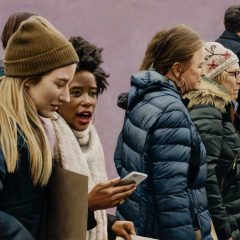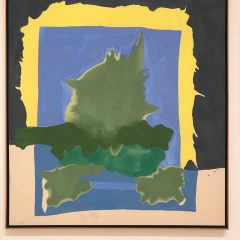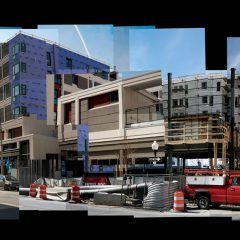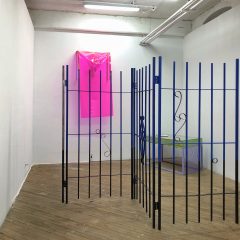—Maeve tells us about a show at the deCordova, in which an artist’s relationship to common objects spurs his use of them in formalist compositions.—the Artblog editors———————->
A common first reaction to Tony Feher’s lively retrospective at the deCordova Sculpture Park and Museum in Lincoln, MA is, “Why is this art?” Upon entering the gallery, visitors are immediately submerged into a playful mecca of humble found materials. Coca Cola crates, empty jars, marbles, caps, plastic bottles, broomsticks, ice cube trays and fake flowers have all found a home here. Amidst this panoply, it can be difficult to take the time to look beyond the everyday use of each component and embrace its inherent characteristics. Unlike Pop artists, who toy with the commonplace as a commentary on modern consumerism and our media-saturated culture, Feher (pronounced “fair”) is devoted to pure formalism. He looks to the beauty of these often overlooked ready-mades and pairs or stages them in order to highlight their unique architecture— their texture, light, color and shape. For Feher, the play of light on a single marble is more interesting than its role in our society as a toy or object of schoolyard exchange.
When a jumble is not a jumble
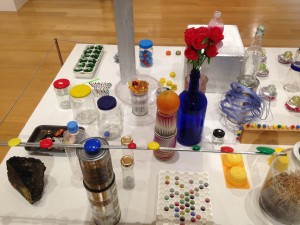
The show opens on a glorious spread of Feher favorites. “Take It Up With Tut” consists of a wide array of stacked, poured, tied and carefully-positioned objects on an immense worktable. As is his wont, Feher lived with this piece in his Bronx studio for a long while (years, most likely), meticulously adding, removing and rearranging elements until it was ultimately ready for display. This artwork in particular introduces us to Feher’s sculptural vocabulary, providing us with an overview of the key elements— marbles, coins and jars, in particular— that will be explored throughout the exhibition in various different formations.
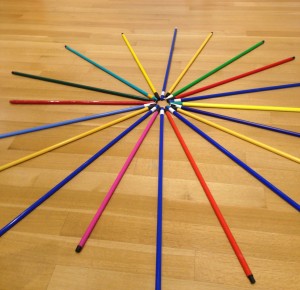
Next up is “Sharadiant,” a spiral of mop and broom handles, buzzing with vivacious primary colors. Having amassed these sticks after years of Lower East Side garbage scrounging, Feher stages a very simple intervention: rather than transforming his materials (by cutting, painting or casting them), he merely uses their existing hanging holes to string them together, creating a formalist play of line, space and hue.
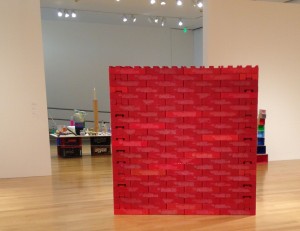
Similarly, “Enjoy,” a red fortress-like structure, is made by assembling Coca Cola crates and letting them stack, in accordance with their original functionality. Feher even scratched out the logos with hieroglyphic-like white markings in order to emphasize that the brand is not what’s important here— only the aesthetic traits. “Enjoy” also highlights the role that Feher’s own body plays in his artwork. The dimensions of the structure match the artist’s height and arm span.
Feher’s very personal relationship with his objects
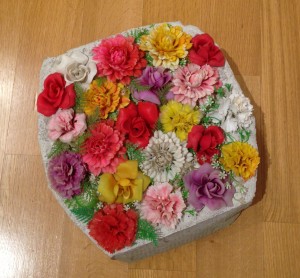
Feher’s deteriorating body after his HIV diagnosis is often cited as the inspiration for his choice of supplies. Transient, degradable materials point to the short life cycles of both objects and human beings. On the other hand, the fact that so many of these cardboard, plastic and highly-perishable items are still intact after more than twenty years reveals their durability against all odds— a more hopeful message that echoes Feher’s own improbable survival (he is still alive and well in 2013).
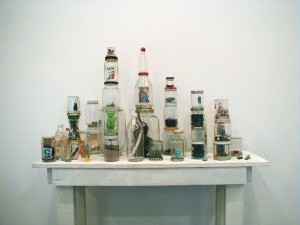
In the late 1980s, an HIV diagnosis implied a death sentence, leading Feher to reexamine his artistic career and legacy. “Long Term Pillow” is the result of such introspection, a cement stone covered with deceptively-cheery bogus carnations. Resting somewhat ominously on the gallery floor, the rock was intended as a cushion for the artist’s dead body. The heavy permanence of the cement deliberately belies the ephemeral nature of human livelihood. Another funerary piece, “Le Roi de Bâton” is a reliquary, or ode to the artist’s life. A collection of his IV fluids, medication and fingernail clippings, this deeply personal assemblage is a sort of altar to Feher’s transitory existence.
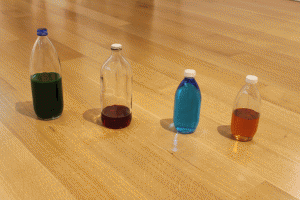
In the second gallery, a row of bottles glowing with colored fluids greets us, some vibrating with intensity while others remain muddier. One of Feher’s early bottle pieces, “Look See” is made with transmission and brake fluid, radiator coolant and Windex®, all dyed distinct colors for identifying purposes. Surprisingly intact, this work’s extreme light sensitivity led Feher to later favor water tinted with food dye, a more durable substance. Unfortunately, this excluded the original variation in opacity apparent here— while translucent water captures the play of light well, it cannot take on more impervious textures.
The influence of light on the artist and the work
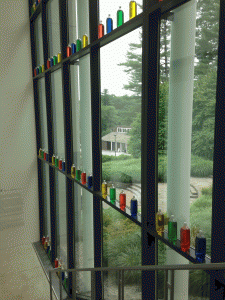
A more recent incarnation of Feher’s work with bottles, “Wishing Well Wishes Well” is a stunning, almost overwhelming proliferation of brightly-colored containers spanning the length of the deCordova’s three-story staircase. When the artist first visited the site, he identified this grand staircase, encased on one side by geometrically outlined windows, as the iconic architectural feature of the institution. As such, he chose to pursue one of his three site-specific installations there. Row upon row and column upon column of red, blue, yellow and green bottles flicker with sunshine, enveloping the building and transforming it into a brilliant stained glass vision. Obsessed with patterning, the artist made sure to alternate the sequence of colors so that no one column consisted of a single color.

The play of light is also a fixation for Feher, whose outdoor site-specific piece, “The Nothing Before Something,” is a beacon of pulsating fluorescent pink shooting up toward the horizon. Painted DayGlo brand “Aurora Pink,” this work references Stephen Hawking’s theory of singularity— the moment of infinite collective energy before the explosion of the Big Bang. Particularly in the afternoon, the painted utility pole literally vibrates with neon intensity.
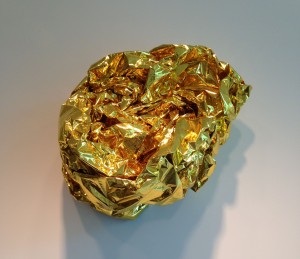
Other notable artworks in the show include “Untitled” (nicknamed “Nugget”), a shimmering golden Mylar blanket scrunched and held together by a binder clip, from which it hangs quite beautifully on the wall. For those who enter by the main staircase, this candy-like revelation will be their first glimpse of the show. “Until Tomorrow,” in the gallery next door, is a whimsical string of empty baby formula jars, each carrying a single marble. Reminiscent of the simplicity of post-minimalists like Richard Tuttle, this piece celebrates the splendor of modest, fastidiously-arranged forms.
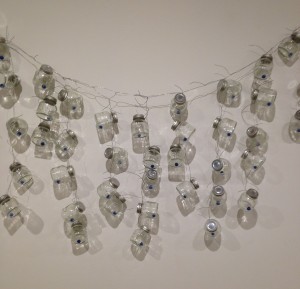
Feher’s brand of formalism, minimalism and attention to ordinary beauty has made this show quite a success, attracting droves of local artists and curators. Some of the latter have signed on to give personal tours of the exhibition, recounting how Feher’s work influenced their own artistic growth and practice. It is clear that the museum, Assistant Curator Lexi Lee Sullivan in particular, made a mammoth effort to foster a productive and respectful relationship with Feher. While the show originated at the Blaffer Art Museum, where Director and Chief Curator Claudia Schmuckli spearheaded its curatorial vision, the deCordova is a perfect host, fostering a unique iteration of the original installation.
An exceptional combination of contemporary sculpture center and art museum, the deCordova’s summer exhibitions are well worth the drive; both aspiring and well-established artists will learn to rethink their understanding of objects and architecture. A lack of explanatory wall text fosters a fluid, uninhibited engagement with the artwork, while highly-trained security guards remain at the ready to ask you incisive questions and kindly help your understanding along.
The show will be traveling closer afield, to the Bronx Museum of the Arts in October. It will be interesting to see what new formations take place there. Perhaps Feher will incorporate his work into the institution’s dynamic exterior folds, which jut out expressively onto the Grand Concourse.
“Tony Feher,” to September 15, deCordova Sculpture Park and Museum, 51 Sandy Pond Road, Lincoln MA 01773. Future sites: Bronx Museum of the Arts, New York, October 6, 2013 – February 16, 2014 & Akron Art Museum, Ohio, April 12 – August 17, 2014.


